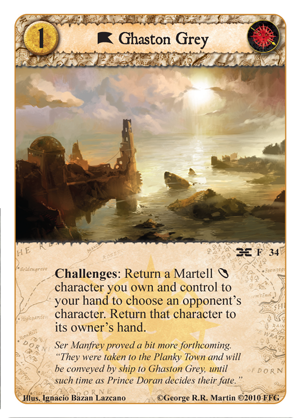Tidings from the CitadelThe updated FAQ and tournament rules for A Game of Thrones: The Card Game
Behind the closed doors of Old Town’s Citadel, the great Conclave of maesters met to address the course of A Game of Thrones: The Card Game. Bound to serve all of Westeros, publicly swearing off any house loyalties, these scholars have looked deep into the game’s wealth of cards and its metagame. They have considered the questions arising from lords and common folk alike. Now, ravens carry their advice far and wide…
The 2012 Regional Championship season for A Game of Thrones: The Card Game is nearly upon us! Today, you’ll find all the rules updates to carry you through this exciting tournament season. Both the new A Game of Thrones FAQ 3.2 (pdf, 16.9 MB) and the updated A Game of Thrones Tournament Rules (pdf, 2.8 MB) are now available for download.


You can also find these documents available for download, along with a printer-friendly version of the FAQ, on the game’s support page.
The game’s developers introduce the new FAQ and provide rationale for several of the recent changes.
Direct from the Old Town rookery
Hello A Game of Thrones: The Card Game players!
A new Regional Championship season is nearly here! In preparation, we have written FAQ 3.2 to address a few rules clarifications and metagame balance issues before regional season kicks off.
Duplicates
The main rules clarification issue to address is that of Duplicates. The Core Rulebook spelled out a list of effects from which Duplicates could be used to save their attached cards. Unfortunately, this list was written before a major game mechanic was introduced–Shadows. What should happen when a unique card with a duplicate would be sent back to Shadows? Duplicates were intended to protect their attached card from anything that caused that card to leave play; however, the Core Rulebook only allowed Duplicates to protect cards from the ways that they could leave play at that time. We wanted to make sure it was clear that you can use a Duplicate to save any unique card from any attempt to make that card leave play, including any time a card would be forced into Shadows.
Errata
Metagame balance is always an important consideration as we head into a major tournament season. Of particular concern are any cards which might have a major negative impact on participants’ enjoyment of these tournaments. Two cards that have fallen into this category lately are Ghaston Grey (Forging the Chain, 34) and Robert Baratheon (The Tower of the Hand, 46).


When Ghaston Grey was originally released, House Martell had a very small selection of high-priced Noble-crested characters. Strategies built around this location were quite effective, but the player using Ghaston Grey also had to keep paying to bring out his or her Noble characters each turn to use Ghaston Grey. Since then, however, House Martell has received several lower-cost Noble-crested characters that have allowed players using Ghaston Grey to create a significant resource advantage by returning their own low-cost Nobles to return their opponents’ high-cost characters. Rather than restrict Ghaston Grey, we have chosen to errata it so that it can only affect opponents’ characters of equal or lower printed cost. Ghaston Grey can still be used to good effect, but it no longer nets the House Martell player a resource advantage that can be disheartening to try to overcome.
When the King’s Landing cycle was released, Shadows was a major new mechanic for the game. As such, Shadows cards were very commonly played. This made the limitation on Robert Baratheon’s ability very significant. Now, while Shadows cards are still used, they are seen less frequently in the environment, and Robert’s ability becomes that much more powerful and potentially environment-warping. This became most recently evident with the new Night’s Watch character, Satin (Where Loyalty Lies, 79). With just a few cards, a player with Robert and Satin could potentially discard his or her opponent’s entire deck in one phase.
 Robert Baratheon’s ability to stand any number of times per phase put a significant limit on the design of cards that only require a character to kneel as the cost. By limiting the number of times Robert can stand each phase we leave room to design cards that require a character to kneel without having to worry about how Robert’s ability will interact to create abusive combinations.
Robert Baratheon’s ability to stand any number of times per phase put a significant limit on the design of cards that only require a character to kneel as the cost. By limiting the number of times Robert can stand each phase we leave room to design cards that require a character to kneel without having to worry about how Robert’s ability will interact to create abusive combinations.
The Laughing Storm
It is not all bad news for House Baratheon, however. After consideration, we have removed The Laughing Storm (Gates of the Citadel, 5) from the Restricted List. With a surge of decks heavily focused on the Intrigue challenge, bolstered in part by the release of Lions of the Rock, this change gives Baratheon players a bit more space to protect their hand without limiting their options.
We hope everyone has a great time at the 2012 Regional Championship tournaments!
–The A Game of Thrones: The Card Game Design Team
...
Source:
Tidings from the Citadel

